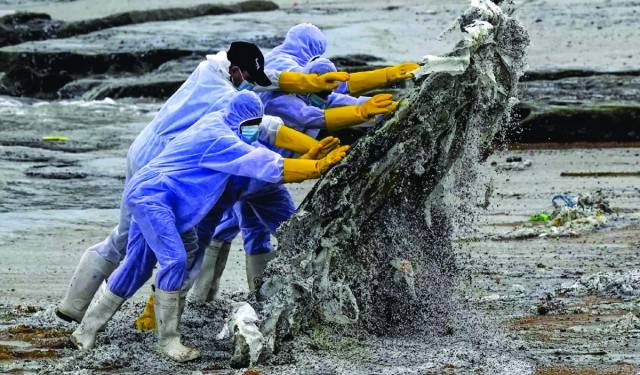
Sri Lanka, the ‘Pearl of the Indian Ocean,’ a tourist treasure known for its glorious beaches, delicious seafood and breath-taking coastline; recent days have taken away these images which had become synonymous with the island-nation and replaced them with photographs of ecological destruction.
60,000 ships travel in and out of Sri Lanka annually, but all it takes is one potentially catastrophic event to pose the gravest risk to the environment. Unfortunately for Sri Lanka, it has now faced two such catastrophes within the span of 10 months; the most recent one being the most devastating.
The ship MV X-Press Pearl entered Sri Lankan waters on May 20, and had an acid leak on board from one of its containers which was not reported. It finally sank about 9.5 nautical miles from the Colombo harbor a few days ago, but did not sink fully because it was touching a coral bed. The ship had been burning since entering Sri Lankan waters, but an explosion six days after this date brought disaster in the form of small white plastic pellets spread around almost one third of the coastline, from the coastal cities of Galle to Kalpitiya.
The pellets are low density polyethylene plastic nurdles, and this widespread pollution has painted Sri Lanka’s beaches white; not because of the gorgeous sand, but because of the sheet of plastic which has taken away the glorious sanctity of what the island was known for. Images showing dead turtles washing ashore and beaches covered in these pellets have emerged as authorities issued a ban on fishing in the area.
The Singapore-flagged cargo vessel was carrying a consignment of hazardous chemicals including nitric acid, ethanol, lead ingots, dust urea, frilled urea, high density and low-density polyethylene (46 containers), epoxy resins (349 containers), sodium methoxide, caustic soda (42 containers), aluminum processing byproducts, raw materials for cosmetics, food items and general cargo from Qatar and Gujarat to the Colombo port. The ship also had 300 tonnes of bunker oil.
With the sinking of the ship, the release of the chemicals poses a serious risk to the ocean and the coastal ecosystem. The Nitric acid will damage the corals and ocean life as it is a highly corrosive chemical, and the burned plastics are polluting the air, however the spreading of plastic pellets is the most immediate and disastrous impact seen so far. While cleaning efforts could remove half the plastic beads, the rest will stay mixed with sand and in the coral beds, continuing to kill ocean life for many more years. In this lies the greatest of tragedies.

Sri Lankan environmentalist Dr Ajantha Perera questioned why the MV X-Press Pearl vessel was given permission by local authorities to enter Sri Lankan waters. “No matter how much compensation we receive, it is not enough to restore the damage to our environment. The Environment Ministry should act more responsibly. Procurement of equipment and training of Navy and Maritime Authority officials should be done to prevent such disasters in future,” she added. SLPA Chairman General (R) Daya Ratnayake confirmed that the Colombo Port had not been initially informed of the acid leak. Shumel Yoskovitz, chief executive of the ship’s operator X-Press Feeders, apologised for the disaster, saying in an interview with Channel News Asia last week: “I’d like to express my deep regret and apology to the Sri Lankan people for the harm this incident has caused both to the livelihood and environment of Sri Lanka.” Apology is too little, too late.
The fact that human error with regards to not informing the relevant authorities about the acid leak itself have led to such a disastrous maritime tragedy unfolding in Sri Lankan waters only adds to the on-going stresses already plaguing the country.
“This is probably the worst beach pollution in our history,” said Dharshani Lahandapura, head of Sri Lanka’s Marine Environment and Protection Authority (MEPA). Thousands of military and security personnel in hazmat suits are currently in the throes of cleaning the beaches of plastic waste and other debris from the ship, and the impact on mangroves, lagoons and marine wildlife in the region is also currently being assessed. The jobs of thousands of fishermen are at risk, according to authorities, and the MEPA said an oil leak would only add to the devastation. Now, satellite images reveal a huge oil slick has poured into the water surrounding the damaged vessel. The images, taken on Monday, show the slick is several hundred meters long. Evidence of the spill comes just days after attempts to assess the vessel for leaks were delayed due to rough seas and poor conditions. The environmental impact of the disaster is being closely monitored by the International Maritime Organization.
Sri Lanka has not signed the Hazardous and Noxious Substances Convention, and had they become a signatory to the convention and incorporated it into the domestic law, the country would have been in a better position to claim compensation for the damage done.
The question that plagues the country now is this one; are Sri Lankans willing to do their part to cultivate more awareness with regards to the serious nature of ecological tragedies? Apart from sharing hellish images of the fire which raged on for days, and of the pellets which will undoubtedly impact thousands of jobs for fishermen, as well as cause the loss of countless cores of marine life, will this story too be one that is washed away under a wave of ultimate apathy? Human beings on the whole need to develop more of an urgent need to establish accountability; one day, we will ruin our coasts, and cities and environment, and wonder why it is that nature heals only when we are caged in our houses during curfew. The answer is quite simple: because human error is no longer around to destroy it.
The writer is a lawyer, teacher and political commentator based in Colombo, Sri Lanka. She can be reached on Twitter @writergirl_11
60,000 ships travel in and out of Sri Lanka annually, but all it takes is one potentially catastrophic event to pose the gravest risk to the environment. Unfortunately for Sri Lanka, it has now faced two such catastrophes within the span of 10 months; the most recent one being the most devastating.
The ship MV X-Press Pearl entered Sri Lankan waters on May 20, and had an acid leak on board from one of its containers which was not reported. It finally sank about 9.5 nautical miles from the Colombo harbor a few days ago, but did not sink fully because it was touching a coral bed. The ship had been burning since entering Sri Lankan waters, but an explosion six days after this date brought disaster in the form of small white plastic pellets spread around almost one third of the coastline, from the coastal cities of Galle to Kalpitiya.
The pellets are low density polyethylene plastic nurdles, and this widespread pollution has painted Sri Lanka’s beaches white; not because of the gorgeous sand, but because of the sheet of plastic which has taken away the glorious sanctity of what the island was known for. Images showing dead turtles washing ashore and beaches covered in these pellets have emerged as authorities issued a ban on fishing in the area.
The Singapore-flagged cargo vessel was carrying a consignment of hazardous chemicals including nitric acid, ethanol, lead ingots, dust urea, frilled urea, high density and low-density polyethylene (46 containers), epoxy resins (349 containers), sodium methoxide, caustic soda (42 containers), aluminum processing byproducts, raw materials for cosmetics, food items and general cargo from Qatar and Gujarat to the Colombo port. The ship also had 300 tonnes of bunker oil.
While cleaning efforts could remove half the plastic beads, the rest will stay mixed with sand and in the coral beds, continuing to kill ocean life for many more years
With the sinking of the ship, the release of the chemicals poses a serious risk to the ocean and the coastal ecosystem. The Nitric acid will damage the corals and ocean life as it is a highly corrosive chemical, and the burned plastics are polluting the air, however the spreading of plastic pellets is the most immediate and disastrous impact seen so far. While cleaning efforts could remove half the plastic beads, the rest will stay mixed with sand and in the coral beds, continuing to kill ocean life for many more years. In this lies the greatest of tragedies.

Sri Lankan environmentalist Dr Ajantha Perera questioned why the MV X-Press Pearl vessel was given permission by local authorities to enter Sri Lankan waters. “No matter how much compensation we receive, it is not enough to restore the damage to our environment. The Environment Ministry should act more responsibly. Procurement of equipment and training of Navy and Maritime Authority officials should be done to prevent such disasters in future,” she added. SLPA Chairman General (R) Daya Ratnayake confirmed that the Colombo Port had not been initially informed of the acid leak. Shumel Yoskovitz, chief executive of the ship’s operator X-Press Feeders, apologised for the disaster, saying in an interview with Channel News Asia last week: “I’d like to express my deep regret and apology to the Sri Lankan people for the harm this incident has caused both to the livelihood and environment of Sri Lanka.” Apology is too little, too late.
The fact that human error with regards to not informing the relevant authorities about the acid leak itself have led to such a disastrous maritime tragedy unfolding in Sri Lankan waters only adds to the on-going stresses already plaguing the country.
“This is probably the worst beach pollution in our history,” said Dharshani Lahandapura, head of Sri Lanka’s Marine Environment and Protection Authority (MEPA). Thousands of military and security personnel in hazmat suits are currently in the throes of cleaning the beaches of plastic waste and other debris from the ship, and the impact on mangroves, lagoons and marine wildlife in the region is also currently being assessed. The jobs of thousands of fishermen are at risk, according to authorities, and the MEPA said an oil leak would only add to the devastation. Now, satellite images reveal a huge oil slick has poured into the water surrounding the damaged vessel. The images, taken on Monday, show the slick is several hundred meters long. Evidence of the spill comes just days after attempts to assess the vessel for leaks were delayed due to rough seas and poor conditions. The environmental impact of the disaster is being closely monitored by the International Maritime Organization.
Sri Lanka has not signed the Hazardous and Noxious Substances Convention, and had they become a signatory to the convention and incorporated it into the domestic law, the country would have been in a better position to claim compensation for the damage done.
The question that plagues the country now is this one; are Sri Lankans willing to do their part to cultivate more awareness with regards to the serious nature of ecological tragedies? Apart from sharing hellish images of the fire which raged on for days, and of the pellets which will undoubtedly impact thousands of jobs for fishermen, as well as cause the loss of countless cores of marine life, will this story too be one that is washed away under a wave of ultimate apathy? Human beings on the whole need to develop more of an urgent need to establish accountability; one day, we will ruin our coasts, and cities and environment, and wonder why it is that nature heals only when we are caged in our houses during curfew. The answer is quite simple: because human error is no longer around to destroy it.
The writer is a lawyer, teacher and political commentator based in Colombo, Sri Lanka. She can be reached on Twitter @writergirl_11

